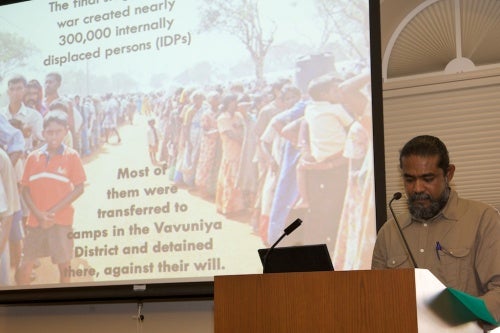
The Sri Lankan journalist gave a brief overview of the island nation's history from pre-colonial times through the 25-year civil war between Tamil separatists and the Sinhalese-majority government. He also described the humanitarian crisis after the most recent outbreak of violence in 2009 and the suppression of the media by the Sri Lankan government.
Citing reports by the U.N. and the Times of London, Balasooriya estimated there were between 7,000 and 20,000 civilian casualties during the final stages of the conflict between the Sri Lankan government and Tamil separatists, which ended with the death of Tamil Tigers leader Velupillai Prabhakaran in May of 2009.
Balasooriya said that 300,000 Tamils were displaced from their homes during the violence. To this day, he said, 200,000 are still confined to internment camps. He showed photos of the largest camp, Manik Farm, which houses 120,000 people in tents and spans 20 kilometers. He said the government has barred journalists and detainees' family members from the camps.
In addition, he said, it has threatened and imprisoned journalists, and 34 media workers have been killed this year. Journalist Jayaprakash Sittambalam Tissainayagam received a 20-year prison sentence for writing articles criticizing the Sri Lankan government's conduct during the war. Balasooriya concluded his talk by talking about his work with the Sri Lanka Working Journalists’ Association, the Free Media Movement, and Journalists for Peace. These Sri Lanka-based groups have been leading demonstrations inside Sri Lanka and raising international awareness about the humanitarian crisis and the government's suppression of the press.
You can learn more about the humanitarian conditions in Sri Lanka and the suppression of the media by visiting the online resources devoted to Sri Lankan issues on the Amnesty International, Reporters without Borders, and International Federation of Journalists Web sites.